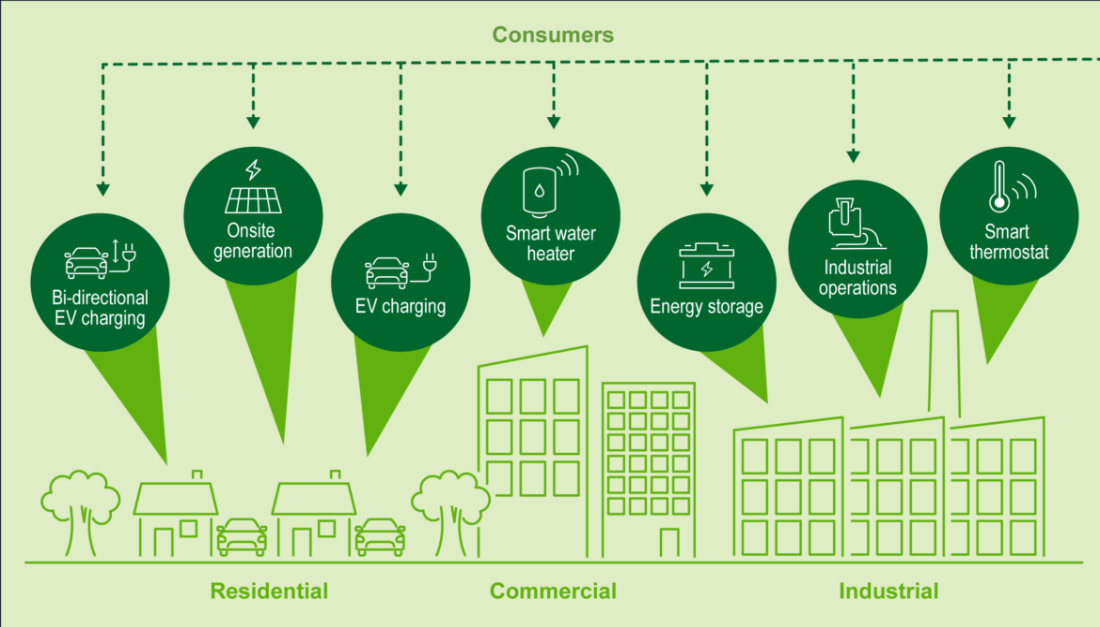What are VPPs? And, how can they help?
Your smart home devices, electric vehicles (EVs), rooftop solar panels, smart thermostats, heat pumps, and battery energy storage systems.... help us do things in our homes, but they can do more!

Virtual Power Plants (VPPs) sound like a big thing, but they are rather large groups of small devices such as smart appliances, rooftop solar with batteries, EVs, and chargers. With these devices, residential, commercial, and industrial users can work together to balance electricity use and provide the entire grid with services like a big electric power plant.
VPPs enroll device owners in a way that offers them financial rewards for contributing to efficient grid operations. These owners include residential, commercial, and industrial electricity consumers. As an example, demand response aggregators (like Meltek) perform as VPPs to help consumers receive money for saving energy during peak times, while helping balance the supply and needs of the grid overall.

Examples of consumer-side VPPs
With peak electricity demand rising while old coal and gas power plants are being retired, the U.S. grid will face more significant pressures, especially during periods of peak demand. By connecting Distributed Energy Resources in millions of homes with power electronics and control systems, VPPs could expand the nation’s grid capacity to reliably support rapid electrification while redirecting grid spending from Peaker Plants to participants and reducing overall grid costs by $10 billion per year.
For utilities, VPPs are dispatchable (meaning the utility has some control) power plants that happen to be cheaper, more reliable, and cleaner. When in need of capacity, grids can call on VPPs for help. Through connected solutions, utilities have access to megawatts of capacity that help smooth the peaks, making grids more reliable. According to research by Brattle, an economic consultancy, the costs to a utility procuring peak capacity from a VPP can be 60% lower than from a natural gas plant. Utilities would rather pay consumers for contributing to grid flexibility than pay for Peaker Plants, which are typically highly polluting and costly power plants that only operate during peak usage periods.
Consumers are paid per kilowatt-hour (kWh) of energy or per kilowatt (kW) of capacity. By optimizing their EV charging, thinking about batteries for backup power instead of a generator, or simply adjusting the temperature of the house on an app on their smartphone, consumers earn money from VPP companies, helping offset their upfront purchase costs for the DERs. By adopting smarter and more efficient systems, consumers will further understand their energy usage in ways that save them money and decarbonize and strengthen the grid.
Another important benefit of VPPs is for communities. When enough households in a community own batteries, use smart devices, or install solar panels, they can create their own networks using smart technology, and entire neighborhoods can support the grid together. This will enable consumers to optimize energy costs, use, and source.
With the variety of smart electrical devices, consumers can do many things to function as part of a VPP: use electricity from on-site solar systems during peak hours, have a flexible schedule of EV charging to avoid overloading the local grid system, and charge distributed batteries with clean electricity when renewables are abundant to avoid electricity shortages.
Considering VPPs' benefits to consumers, communities, utilities, and the entire grid, they can play a pivotal role in reshaping our energy landscape. According to the Department of Energy, if we triple the capacity of VPPs between now and 2030, 10 to 20% of peak load nationally can be served through virtual power plants. The result? A cheaper, cleaner, more sustainable, and reliable power grid. Our choices, from using smart thermostats to enrolling in demand response programs, are not just about personal convenience or savings; they are stepping stones towards a collective energy transformation, turning every home into an energy solution for the future.
Ready to Start Earning?
Join thousands of users who are already earning rewards while helping the environment.